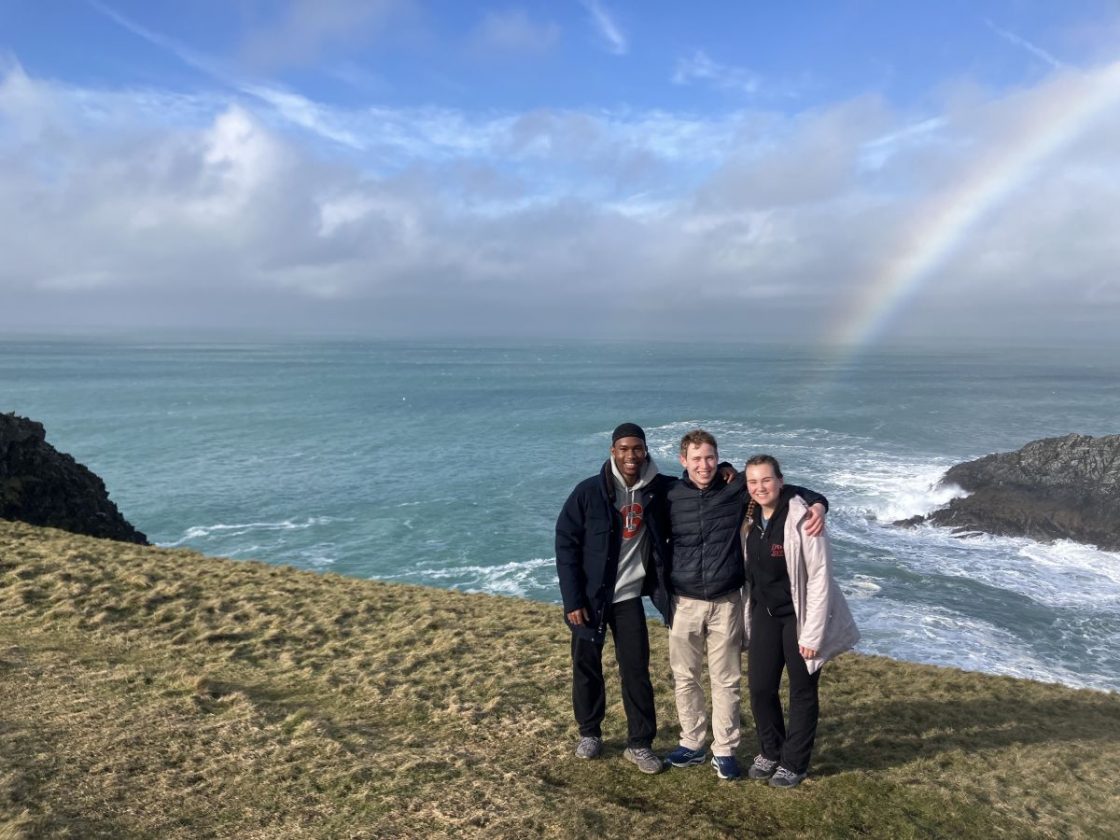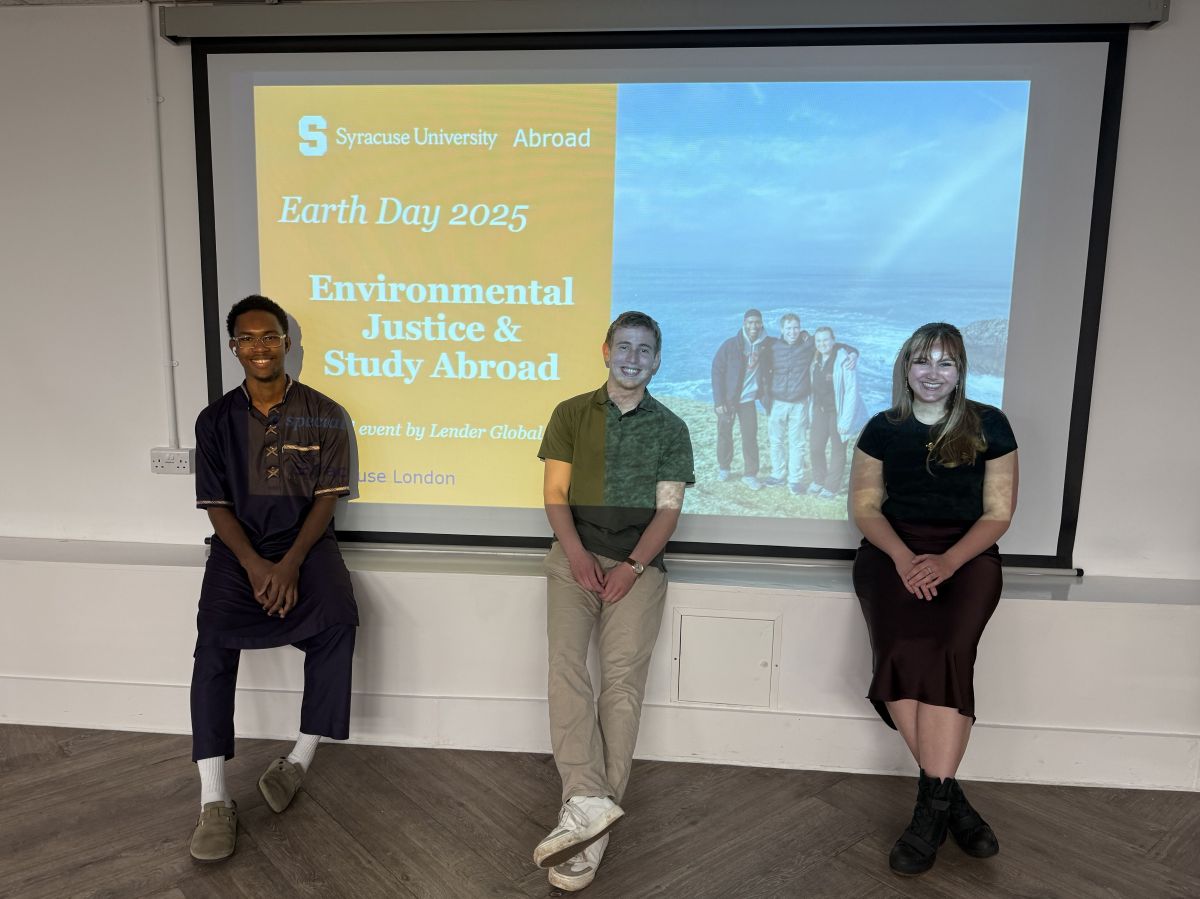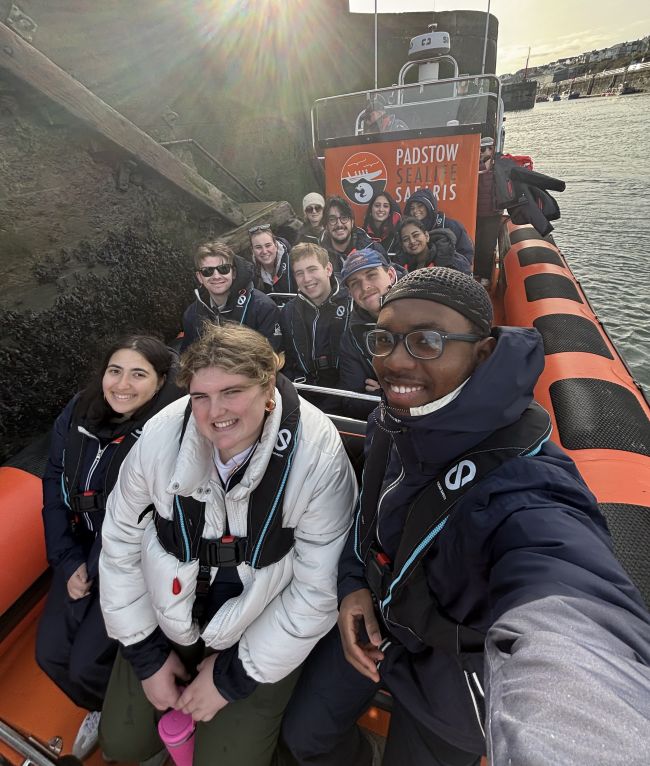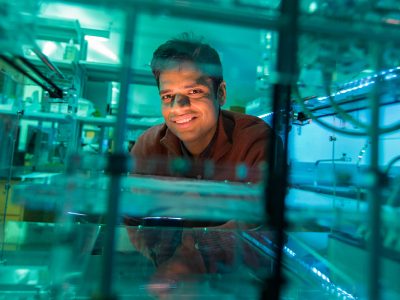
Lender Global student fellows, from left, Jibril Barrie, Jude Bazerman and Gabbie McCafferty found a rainbow during an eco-tour outing to Polly Joke Beach, an area on the north Cornish coast.
Lender Global Student Fellows Share Sustainability Research
Three undergraduate students combined a traditional study abroad experience with an international research opportunity last spring, exploring biodiversity, ecology, green space design and climate justice across the United Kingdom.
The trio, based in London, was the first cohort of Lender Global student fellows. Created last year as a partnership between Syracuse Abroad and the Lender Center for Social Justice, the Lender Global program supports undergraduate research in international locations.
The students will discuss their work at the Lender Symposium Nov. 7 along with a presentation of the media project research completed in 2023-25 by Lender Faculty Fellow Nausheen Husain and her student team.
Research Highlights
Abdulai Jibril Barrie ’26, an industrial and interaction design major in the College of Visual and Performing Arts, examined the environmental impact of Muslim pilgrimages. He found that during Hajj, millions of people converging in Mecca produces 1.86 million kilograms of CO2—equivalent to 400,000 cars driving for an entire year. His research explored how Islamic teachings about environmental stewardship can guide pilgrims to offset their carbon footprint through the Green Hajj initiative, which promotes tree planting donations, clean energy use, resource conservation, litter-free public spaces and reusable travel items like toiletries containers, tote bags and portable prayer mats.
Jude Bazerman ’26, a dual major in broadcast and digital journalism in the Newhouse School and geography and the environment in the Maxwell School, investigated climate vulnerability among immigrant populations. His research revealed that Bangladeshi immigrants who fled to London to escape poverty and environmental devastation from flooding ended up in Tower Hamlets—one of London’s neighborhoods most at risk for flooding. His findings underscore how, without aggressive safety and regulatory interventions, the impact of climate change may follow vulnerable populations to their adopted locations.
Gabrielle McCafferty ’25, a biology major in the College of Arts and Sciences, studied how international tourism threatens biodiversity. Assessing tourist activity in France, Spain, England, Italy, Singapore and Chile, she documented tourism’s environmental toll and developed recommendations for travelers: minimize waste through recycling and mindful eating, consider how tours impact ecosystems and wildlife, choose walking or public transportation over car services and avoid products that pollute local environments.
The fellows presented their findings at an environmental justice symposium held in London for April’s Earth Day.

Comparative Perspectives
The students observed striking differences between British and American approaches to environmental conservation.
“In the U.K., environmental justice is embedded in the law,” Barrie says. “I was struck by how much effort goes into making sustainability a lived reality, not just a policy goal. The U.S. often treats sustainability as an afterthought.”
Bazerman notes a fundamental cultural difference: “The U.K.—and Europe as a whole—have a ‘we’ approach. The U.S. tends to think through the lens of ‘me.’ In the U.K., environmental issues are much more at the front of people’s minds.”
McCafferty agrees.
“The U.K. certainly has a tighter grasp on the magnitude of the issues facing our environment and stands apart from the U.S. in its willingness to try lots of initiatives to minimize waste and pollution,” she says.

Challenging Assumptions
The research experience challenged the students’ preconceptions about sustainability and environmental practices.
For Barrie, studying the international Law of the Sea revealed how maritime zones are divided and showed that “sustainability is about governance and accountability, not just good intentions.”
Bazerman’s assumptions about migration and climate safety were upended.
“I assumed that living in London would be a significant improvement for people who had migrated from Bangladesh,” he says. “Instead, it was the most at-risk spot for climate change.”
McCafferty was encouraged by what she observed.
“It was pleasantly surprising to see signs on the beaches in Cornwall asking visitors not to disturb the wildlife,” she says. “The ecosystems seemed successfully conserved and people truly cared about protecting them.”
The Lender Global program partners with a different Syracuse Abroad center each year. The second cohort of student fellows is currently studying human rights and historical memory in Santiago, Chile.

